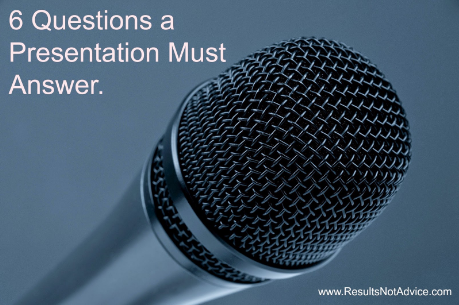
Your success will reflect your ability to speak to a group of people and motivate them to action. The one skill that all sales professionals, executives, small business owners, experts and entrepreneurs must have is the ability to effectively present their message.
They must be able present their message to their prospects, customers, employees, associations, boards, meetings are just a few of the places where you will present.
In any presentation, there are basic pieces of information that an audience should receive from their presenter. You are the problem solver presenting a solution that will benefit your audience. The presentation should answer who, what, when, where, why and how regarding your topic. In giving that information, your presentation will have clarity and will be on track to give the detail necessary to your audience.
1) Who is your target audience?
What would they like to know about regarding your presentation? Do they have any preconceived notions about your material? What are their concerns? Are you addressing the "who" you targeted in your research? When you address the "who" of your message, you are better able to relate with your audience. They will feel like you are speaking directly to them. They will give you their attention because they feel like their needs are being addressed.
2) What is the message you want to communicate?
What are the issues? What are the solutions? The "what" in your message is the backbone of your presentation. It is your purpose of your message and the reason you are speaking. It is also the reason why people come to hear you.
3) When is the recommended time to take action?
Is there a sense of urgency in your presentation? Stressing the "when" aspect of your message is especially important when you want your audience to take action immediately following the presentation - i.e. - sign up for a class, sell promotional materials, implement what was learned)
4) Where is the problem located?
Where can your audience find the help they need? "Where" signifies direction. This leads your audience somewhere in your presentation. Where would you like to take them? Common "where" statements include "across America today", "in college campuses nationwide", "in the construction industry", and "in families in California".
5) Why should they take action?
What are the motivating factors in prompting your audience to take action? The main focus here is inspiration and motivation to take action. Not only do you want them to listen to you, but you want your audience to take action on what you've said. You want to somehow improve their lives and honing your message on the "why" is a critical necessity.
6) How can they respond to your message?
How can they take action based on what they've heard? This is the learning and teaching portion of your message. This can be the "how-to" section telling them how they can easily improve their lives. This section often incorporates steps to follow.
There are still many more questions that your presentation should answer. As you piece all of these bits of information together, you'll be giving your audience the detailed answers they are looking for. You also present yourself as the credible source of information you want to present yourself to be!
Change your Mindset and Change your Results,
Rich
No comments:
Post a Comment